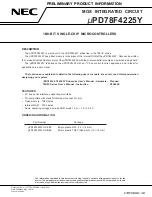
-6-
No.PS
※※
-OMW0005-A
●
Product handling
Installation
Tighten to the specified tightening torque.
If the tightening torque is exceeded the mounting screws and brackets may be broken.
If the tightening torque is insufficient, the product can be displaced and loosen the mounting screws.
Be sure to ground terminal FG when using a commercially available switch-mode power supply.
Do not drop, hit or apply shock to the product.
Otherwise damage to the internal parts can result, causing malfunction.
Do not pull the lead wire forcefully, not lift the product by pulling the lead wire.
(Tensile strength: 50 N maximum for power supply and output cable, 25 N maximum for sensor lead wire with
connector).
Hold the body when handling to avoid the damage of the product which lead to cause the failure and malfunction.
Never mount the product in a place that will be used as a scaffold during piping.
The product may be damaged if excessive force is applied by stepping or climbing onto it.
Wiring
Do not pull the lead wires. In particular, do not lift or carry the product by holding the cables once they
are connected to the product.
Otherwise damage to the internal parts can result, causing malfunction or to be off the connector.
Avoid repeatedly bending or stretching the lead wire, or placing heavy load on them.
If the lead wire can move, fix it near the body of the product.
The recommended bend radius of the lead wire is 6 times the outside diameter of the sheath, or 33 times the
outside diameter of the insulation material, whichever is larger.
Replace the damaged lead wire with a new one.
Wire correctly.
Incorrect wiring can break the product.
Do not perform wiring while the power is on.
Otherwise damage to the internal parts can result, causing malfunction.
Do not route wires and cables together with power or high voltage cables.
Otherwise the product can malfunction due to interference of noise and surge voltage from power and high voltage
cables to the signal line. Route the wires (piping) of the product separately from power or high voltage cables.
Confirm proper insulation of wiring.
Poor insulation (interference from another circuit, poor insulation between terminals, etc.) can lead to excess
voltage or current being applied to the product, causing damage.
Design the system to prevent reverse current when the product is forced to operate for operational check.
Depending on the circuit used, insulation may not be maintained when operation is forced, allowing reverse current
to flow, which can cause malfunction and damage the product.
Keep wiring as short as possible to prevent interference from electromagnetic noise and surge voltage.
Do not use a cable longer than 30 m.
Wire the DC(-) line(blue) as close as possible to the power supply.
Environment
Do not use the product in area that is exposed to corrosive gases, chemicals, sea water, water or steam.
Otherwise failure or malfunction can result.
Do not use the product in an environment where the product is constantly exposed to water or oil
splashes.
If the product is to be used in an environment containing oils or chemicals such as coolant or cleaning solvent, it
may be adversely affected (damage, malfunction, or hardening of the lead wires).
Do not use in an area where surges are generated.
If there is equipment which generates a large amount of surge (solenoid type lifter, high frequency induction
furnace, motor, etc.) close to the product, this may cause deterioration or breakage of the internal circuit of the
product. Avoid sources of surge generation and crossed lines.








































